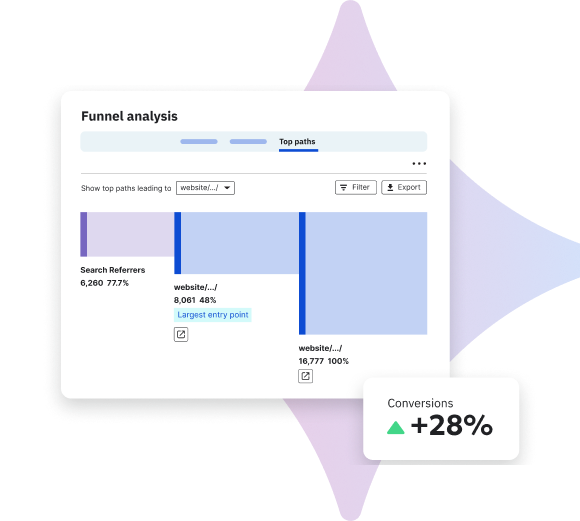No matter where you sit within your organization’s marketing team, one thing is for certain, tracking and measuring performance is an important part of your role. We say this knowing that about 3 of every 4 marketing leaders base decisions on analytics—so whether you’re a campaign manager or content marketer, we know you’re not a stranger to the importance of accurate data-driven marketing.
But there comes a time when every marketer asks themselves, am I tracking the right marketing analytics? Am I really zeroing in on the most important data? How can I make my reporting more efficient?
If this sounds like your inner monologue, fear not. In this blog post, we’ll be exploring the most important analytics for marketers to track by role, and how to better communicate their impact on your organization’s bottom line.
Why marketers love data
Before we get into the metrics every marketer on your team should be tracking, let’s take a step back to understand why data is so important so marketers. That starts with how marketing was viewed historically. For a long time, marketing was considered the “arts department” of many organizations for the simple fact that people believed marketing’s flashy ads or creative campaigns didn’t truly drive sales. Today, we know that effective marketing is a combination of both art and science, and have reporting in place to ensure that marketing’s efforts are accounted for when looking at overall pipeline and revenue numbers.
That said, the first reason marketing data is so important is to be able to measure the effectiveness of your marketing initiatives. Whether you’re analyzing a splashy product launch or a single social media post, marketing analytics allow us to gain an understanding of exactly which marketing programs are making an impact. This helps marketers to prove their ROI and track their contributions to team-wide goals, as well as recycle what has been working well in relation to those goals.
On the flip side, we also want to use marketing data to identify what’s not working and make changes. A close eye on campaign performance lets us spot opportunities for changes, and even helps us to understand where to reallocate budgets and resources if something isn’t proving to be effective.
Tracking and analyzing marketing analytics also helps us to set benchmarks and establish KPIs for our teams, as they relate to our organization’s overarching goals. If you’re not measuring and benchmarking performance overtime, you have no way of improving on it or even knowing if you have improved at all. So no matter your role on the marketing team, data should always be top of mind when it comes to optimizing your efforts and driving results.
Marketing analytics to track by role
While everyone in the marketing department is ultimately pulling for the same goal, the way that each team member contributes differs based on what their job is. This may mean breaking up your organization’s overall revenue targets into smaller milestones like marketing pipeline, leads generated, and even website traffic.
We’ve highlighted four key roles within a marketing team that depend on analytics to do their jobs effectively. Keep reading to see where you fit!
Content marketers
A content marketer’s job is more than just writing copy for blogs and eBooks — a big part of it is also looking at data to determine what types of content resonate most with buyers, the topics that make people click and convert, and whether content is presented in a way that makes sense for their audience.
Below we’ve highlighted the primary goals of a content marketer and which metrics in particular they should focus on to track and measure success.
- Evaluate content performance: Looking at video plays, time spent on an article, and scroll depth can help determine how engaged your audience is with a piece of content.
- Uncover how visitors discover content: Understanding how visitors find content helps you be more strategic about how you organize it. This can involve looking at user journeys and behavior maps to see how visitors are interacting with your webpages, or by looking at internal search data or Google Search Console to see which keywords people are using to look up your content.
- Understand what types of content different users want: This removes the guess work around content creation. Attribute content performance to different sources to determine what type of content resonates best with your various marketing channels. Do organic users interact differently compared to email marketing users? Use behavioral data, external and internal search terms, and conversion points to determine what content to show to who.
Web designers and developers
There are a limitless number of ways you can present and organize information on your company website. And as a web designer or developer, you probably experience change requests coming from all angles based on what people think will perform. But the best way to make strategic decisions about your website design is by digging into the data.
These are the primary outcomes you’d want to evaluate and the metrics associated with them:
- Understand your visitors: The best way to cater to your website visitors is to understand where they’re coming from. As a web designer or developer, this goes beyond demographics like industry or location and takes into account which devices and browsers are most popular amongst your users. This helps you to test and design specifically for their unique browsing experiences.
- Analyze on-page interaction and engagement: Having an idea of how users are interacting with your pages makes it easier to identify areas for improvement—and whether or not they’re engaging with your content in the ways you’ve intended. This includes looking at behavior maps, but also tracking on-page events like clicks on video buttons, clicks that open a lightbox or pop-up, clicks that reveal or hide content on the page, clicks that submit forms without loading a new page, etc.
- Uncover conversion points and roadblocks: Conversions aren’t everything, but in marketing, they do count for a lot. It’s important to understand if your website design is creating a barrier between your visitors and the completion of conversion actions, so ensure that you have true conversion tracking set up, and that you’re not making decisions around high-level data alone. Then, look at the journeys your visitors are taking to get to a point of conversion, and think about what you can do to make that journey easier. It also helps to ensure you have effective conversion tracking in place to be able to analyze the journeys of visitors who have already converted and replicate those.
SEO specialists
When you’re optimizing for anything in marketing—especially SEO—it’s important to use data to track and measure your success. Particularly because the impact of SEO isn’t apparent overnight, specialists have to monitor performance over time to show the impact of their efforts.
For most marketers with a focus on search strategy, this looks like:
- Measuring the quality of search traffic: Looking at traffic will help determine which keywords and their associated pages are driving the most interest. But it’s also helpful to analyze how engaged that traffic is and if there are opportunities to push them further down the funnel with more strategic calls-to-action.
- Discovering opportunities for improvement: Internal search data is not only a great place to find ideas for content, it also helps you to understand the exact wording your visitors are using when looking for answers on your site. Use this to inform your search strategy.
- Tracking how search fits into broader strategy: Search engine optimization alone is not going to help you achieve your marketing goals, so it’s important to track how your search strategy is feeding into your team-wide goals too. Goal or key metric completions are a good indicator that your search efforts are making an impact.
Campaign managers
Campaign managers are responsible for overseeing the entire lifecycle of a marketing campaign, which involves everything from planning, executing, and optimizing. This is a role where data is crucial to making informed decisions about which distribution channels to invest in, how engaging a particular campaign is, and whether or not it’s actually working.
Here’s what should be top of mind analytics-wise as a campaign manager:
- Using UTM parameters to evaluate traffic quality and quantity: Establishing consistent naming conventions for your UTM parameters is essential. It’s what’s going to allow you to filter your traffic by campaign, source, term, and medium. This gives you a ton of insight into your campaigns that you wouldn’t otherwise have—where you’re driving the most traffic from, which channels have a high bounce rate, which sources are providing your most engaged users, and more.
- Gauging overall campaign performance: At the end of the day, it’s your job to create and optimize marketing campaigns. See how one campaign is performing against another by running a campaign comparison. Provided you have the proper tracking in place, you’ll be able to look beyond traffic and deeper into metrics like campaign-level ROI and cost per conversion action instead of just landing page views or bounce rates.
- Tying sprint campaigns into larger marketing and company-wide goals: All of your marketing campaigns should be created with a particular goal in mind—whether that’s generating net-new leads or pushing leads over to MQL status. Whatever you’ve outlined as your goal, make sure the primary actions from your campaign (key page views, button clicks, thank you page views, etc.) are being tracked and roll up into that goal. It doesn’t matter if you’re tracking this in your analytics platform or manually, as long as you (and the rest of your team!) are able to somehow see the impact of your campaigns.
Getting the whole team on board
With a clear understanding of what everyone on your team is responsible for measuring, it is possible for every marketer’s dream of consistent tracking and reporting to be realized.
The most important thing to remember is that everyone on your team is ultimately working towards the same goal, and just like anything else, your analytics reporting shouldn’t be siloed. When you can get your whole team on the same page, you’ll start seeing more efficient and effective analytics action across the board.

Ready to make the most out of your Web Analytics?
Siteimprove Analytics is an all-in-one Web Analytics solution
Schedule a demo
